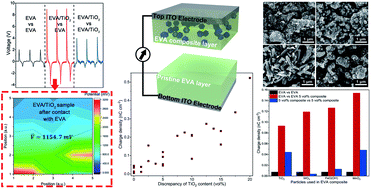Triboelectrification of nanocomposites using identical polymer matrixes with different concentrations of nanoparticle fillers†
Abstract
In this study, we investigate triboelectrification in polymer-based nanocomposites using identical polymer matrixes containing different concentrations of nanoparticles (NPs). The triboelectric surface charge density on polymer layers increased as the difference in nanoparticle filler concentration between the two triboelectric layers escalated, despite the fact that the polymer matrix was the same in both layers. This effect was observed in tests of various polymer types and filler NPs. Our mechanical experiments and finite element analysis simulations confirmed that polymeric triboelectrification is related to the surface viscoelastic deformation that occurs during mechanical contact and separation, and is not dependent on electronic or chemical properties, but rather physicochemical and mechanical properties. This supports the heterolytic scission of covalent bonds in polymer chains as an explanation for the triboelectricity. Accordingly, this study marks a significant contribution to the fundamental understanding of the mechanism of polymeric triboelectrification and will be relevant to the development of triboelectric sensors and energy harvesters.



 Please wait while we load your content...
Please wait while we load your content...